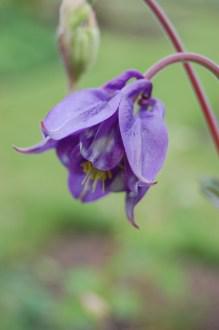
Aquilegia vulgaris Flower (05/05/2012, Kew Gardens, London)
Position: Full sun to partial shade
Flowering period: Late spring to early summer
Soil: Moist, well drained
Eventual Height: 1m
Eventual Spread: 0.5m
Hardiness: 3a – 9b
Family: Ranunculaceae
Aquilegia vulgarisis a deciduous. herbaceous perennial. Its mid green leaves are pinnate, with the basal leaflets being trifoliate. Its blue/ purple hermaphrodite flowers are bell shaped, composed of five petals with hooked spures, arranged in racemes and are borne on erect stems. Its fruit is a small follicle, with is a small upright pod, opening into a deep star shape. These produce small black seeds which readily germinate.
Aquilegia vulgaris, commonly known as European Crowfoot, European Columbine, Common Columbine, Granny’s Nightcap or Granny’s Bonnet, is native to Europe (including the UK), and the west corner of Africa. In its native habitat it grows in woodland glades, open scrub and damp grasslands.

Aquilegia vulgaris (05/05/2012, Kew Gardens, London)
The etymological root of the binomial name Aquilegia is derived from the Latin aquila meaning ‘an eagle’, alluding to the flower spur resembling and eagles claw. Vulgaris is from the Latin meaning ‘common’.
The landscape architect may find Aquilegia vulgaris useful as part of a native wild flower grassland mix. It may also be used as part of a naturalistic woodland glade planting scheme.
Ecologically, A. vulgaris is attractive to bees and pollinating insects.
A. vulgaris prefers moist, fertile, well-drained soils. It tolerates most pH of soil. It will not tolerate dry soils.
Aquilegia vulgaris requires little maintenance. Large clumps may be divided in spring.

